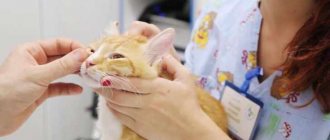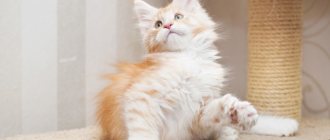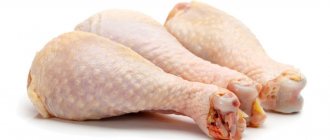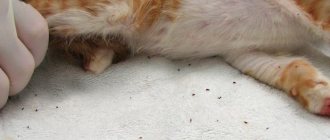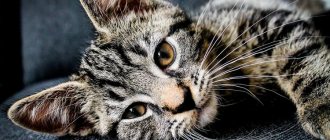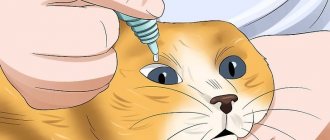Causes of the disease
The main cause of stroke in a cat is the rupture of a blood clot that has formed in the lumen of a vessel. Such a blood clot blocks blood vessels in the brain, which, in turn, stops receiving blood supply. This condition is called ischemia. Ischemia provokes partial or complete death of brain cells.
Cat after injury
The cause of a stroke can also be:
- brain tumors;
- blood parasites;
- spinal and brain injuries;
- congenital brain abnormalities.
Symptoms of Stroke in Cats
You will notice signs of a sharp deterioration in your cat’s well-being immediately.
- The cat's head will be tilted in one direction. This occurs due to the death of brain cells and the resulting weakness of the neck muscles. This pathology can persist for almost a month.
- Impaired coordination of movements. The pet will stagger, skid like a drunk, and may move unnaturally in a circle.
- General muscle weakness, apathy.
- Memory loss. It manifests itself as a strange reaction to household members: the cat may be afraid of you, hide, rush, or sniff you in confusion, as if getting to know you. He may forget the smell and appearance of the house in which he lives, in which case he will behave as if you first brought him into the room.
- Blindness. The cat will bump into furniture and have difficulty finding bowls. Over the course of several days, compensation occurs - other senses become more acute, so the owner may not understand that the pet cannot see. Vision is partially restored over time in most cases. There is an inhibited perception of the picture.
- The pupil sizes will be different.
- Uncontrollability of bowel and bladder emptying processes.
- Sharp twitching (tic) of the eye from side to side.
- Epilepsy or single seizures.
- Paralysis of one side of the body. The cat will lie motionless. If she is conscious but immobilized, it means that part of the body is paralyzed.
- Lack of appetite, vomiting.
- Brief loss of consciousness.
Risk factors
Epilepsy in cats: symptoms, treatment, how to stop seizures
A stroke always happens suddenly, but this acute condition can be prevented if you carefully monitor your cat and undergo routine medical examinations from time to time.
Obesity in a cat
There may be several prerequisites for the occurrence of a cerebral stroke:
- autoimmune diseases;
- chronic hypertension;
- obesity;
- diabetes;
- acute and chronic intoxication of the body;
- chronic stress.
Home rehabilitation
It is clear that a stroke affects all vital functions. Positive dynamics in a sick animal depends on the size of the brain lesion and the location of the lesion.
After a mini-stroke
The cat, as a rule, walks independently, staggers, and may pull its paw. He behaves lethargically, sleeps a lot, eats poorly, and goes to the toilet often. Timely assistance after a micro-stroke restores the pet’s condition by almost 100%.
In more complex cases
rehabilitation can last from two to six months.
The owner will have to be patient and devote as much time as possible to the pet:
Give kisula medications and vitamins as prescribed by the doctor, you may have to give injections;
In the first days, the cat will not move much, it will need to be turned from one side to the other, helped to rise to its paws, and massage its limbs.
Before your pet begins to eat on her own, she will have to be spoon-fed soft, dietary food, and given water using a syringe;
If the animal cannot go to the toilet, but will defecate on itself, then it will be necessary to use diapers or change absorbent diapers more often.
The sleeping area should be soft, warm, without drafts and excess heat.
Main types of stroke
Based on the type of occurrence, strokes are divided into two types:
- ischemic;
- hemorrhagic.
Ringworm in cats: what it looks like, treatment, signs
According to the location of the lesion, strokes occur:
- Micro-stroke. Often you may not even notice, the cat will only be slightly lethargic and mildly disoriented.
- Local stroke is the death of cells in any part of the brain.
- A major stroke involves damage to several areas of the brain at once.
Note! For any form of stroke in a cat, the symptoms and treatment will be almost the same. Only a veterinarian can make an accurate diagnosis using CT or MRI. Different types of stroke require different approaches.
Ischemic stroke
Occurs due to rupture of blood vessels in the brain. The cells of the affected part of the brain suffer from an acute lack of oxygen and lose innervation.
To a greater extent, ischemic stroke is provoked by:
- diabetes;
- chronically high cholesterol;
- Cushing's syndrome;
- blood parasitic infections.
The body responds to injury with inflammation, causing swelling to compress the brain tissue, further blocking the functioning of the affected area.
Hemorrhagic stroke
This type of stroke is a consequence of blockage of a vessel by a blood clot or plaque. Blood does not flow to the area of the brain, which immediately begins to die after the vessel is blocked.
Hemorrhagic stroke most often occurs for the following reasons:
- acute phlebitis – inflammation of blood vessels;
- poisoning by rat poison;
- brain injuries;
- acute and chronic hypertension;
- stress;
- lack of treatment for ischemic stroke;
Symptoms of a stroke
The following signs may indicate a stroke in cats:
- sudden lethargy - the cat had just been jumping and playing, but suddenly fell and froze;
- loss of consciousness;
- failure of the limbs on any side, or failure of the hind or front legs;
- one side of the cat’s face seems to have swollen: a drooping lip, drooling on one side, hearing loss in one ear, the pupil of the eye on the affected side does not respond to light;
- different pupil sizes;
- involuntary urination and/or defecation;
- convulsive attacks similar to epileptic ones. Convulsive seizures may increase in strength, frequency and time;
- unsteady gait, the cat falls to the side;
- disorientation in space, the cat does not seem to understand where it is going;
- a sharp change in character: the animal does not recognize its owners and may rush;
- involuntary twitching of the body and limbs;
- loss of appetite, lack of swallowing reflex;
- the cat walks around the house as if it were here for the first time, sniffs everything or is frightened by every rustle - this symptom indicates a memory impairment.
Cats have different pupils
Any of these symptoms is a reason to contact a veterinary clinic and begin treatment as quickly as possible.
Important! To accurately diagnose a stroke in a cat, only symptoms are not enough; additional examinations will be required - CT or MRI of the brain, as well as general and biochemical blood tests.
Symptoms of the disease
The main symptoms of the disease in a cat usually appear quite clearly, and the owner can notice them even without a veterinary education. If you treat your pet carefully, it is impossible to miss his stroke. In cats, signs of stroke occur acutely and often appear together.
Violation of head position. A sick cat tilts its head unnaturally or moves it mechanically from side to side. This phenomenon occurs due to acute muscle weakness and disruption of nerve impulses. It can persist for another month after the acute phase of the disease, and in severe cases, a cat with a stroke does not recover from muscle weakness and remains with a bowed head.
Balance imbalance. This phenomenon is clearly visible mainly in active cats. They begin to fall, they are carried to one side, they are clumsy. Often the animal begins to move too slowly and walk in circles, while bending its body strangely. With this behavior of the cat, we can say that the stroke is serious. Often this condition is the first sign of a stroke in a cat.
Loss of coordination. The muscle weakness that always accompanies a stroke causes the inability to normally perform even simple habitual movements, such as raising paws to lick.
Visual impairment up to complete blindness. This condition, with timely treatment after the cat recovers, goes away completely or to a large extent. It is extremely rare for cats to remain blind after a stroke. Pronounced lethargy, which is faintly visible in inactive cats, but is immediately visible in active cats, and gives the impression that the pet is tired. If there is no treatment, complete loss of motor activity is possible.
Attack of fear. A cat with a stroke tries to avoid contact with people and tends to hide in a quiet, secluded place. In especially severe cases, a cat, like a dog, with a stroke from a panic attack develops an aggressive state, when even the most affectionate pet can cause serious injuries to its owner.
Eating disorders. The reason for them is still the same - muscle weakness. Because of it, the cat cannot fully chew food and swallow it as usual. Often the cat eats only liquids or even refuses food completely.
Spontaneous urination and defecation. This does not always happen and usually only occurs with very severe damage, or if the stroke affects not the brain, but the spinal cord, which also happens.
Frequent uncontrolled movement of the pupils and twitching of the eyes. This is a 100% sign of a stroke, which does not occur with any other diseases. This is the main symptom of a stroke for a cat.
Fainting. It occurs immediately at the moment of a stroke and can last from a few seconds to 5 minutes. With the rapid development of the disease, the cat dies without regaining consciousness within a period of several minutes to a day. Even modern veterinary medicine is unable to help an animal in this condition.
Cramps affecting only one side of the body. The condition is a sign of damage to the motor areas of the brain.
Paralysis of one paw or all paws. Also, when a cat has a stroke, its legs may be lost on one side of its body. The cat does not walk, but crawls.
Short-term memory loss, due to which the animal ceases to navigate and, even being in a familiar home environment, cannot independently find its bowl
This condition only increases stress, and therefore it is important for the owner to constantly be near the animal, unless, of course, it is aggressive, and help it navigate.
In rare cases, the symptoms of a stroke in an animal may not be typical and cause difficulties in diagnosing the disease. Typically, this can occur if the stroke is weak and the cat’s body is strong. These atypical manifestations of the disease include:
- vomit,
- diarrhea,
- rapid breathing.
shutterstock
If the animal is shown to a veterinarian in this state, he will be able to determine the pathology by the condition of the eyes, which always undergo changes to a greater or lesser extent during illness. This is a characteristic sign of a stroke.
First aid for stroke
First aid can play a critical role in recovery. If a stroke is suspected, owners can do the following:
- place the cat so that its head is approximately 40-45 degrees higher than the rest of the body;
- provide the animal with access to fresh air, remove the collar, if any;
- if vomiting occurs, lay the cat’s head to one side and slightly down;
- Contact a veterinary clinic immediately.
Piroplasmosis in cats: symptoms and treatment
Important! If vomiting or convulsions occur, under no circumstances should you try to open the cat's jaw with your fingers or any other objects. There is a high risk of damaging the cat’s oral cavity, knocking out its teeth, and getting severe bites.
First aid
If the fellinologist notices one or more of the pathological symptoms of a stroke described above, his task is to deliver the cat to the clinic without causing harm during transportation. To do this, the cat owner must comply with the following requirements:
- Place the animal on a leveled solid surface
- Turn your head to the side and hold it carefully so that the cat does not choke on vomit.
- When regurgitation contractions occur, the mouth is cleared of expelled conglomerate.
- During delivery, the cat is petted, calmed, and praised.
- You cannot give pills, give injections, or apply cold to the head.
With a stroke, anisocoria is observed - unequal pupil size
Treatment
Stroke is a very serious diagnosis, and diagnosing and, especially, treating such a disease is only possible in a veterinary clinic with modern equipment. According to recent studies, homeopathy, antioxidants and nootropics have no proven effectiveness. So the use of such drugs as Gamavit, Mexidol and Cerebrolysin is simply a scam of owners out of money.
After diagnosis, depending on the type of stroke, the doctor will prescribe treatment, which should include:
- antispasmodics;
- painkillers;
- analeptics;
- anticoagulants;
- diuretics;
- sedatives (for severe convulsions);
- anti-inflammatory drugs;
- oxygen therapy (oxygen).
Oxygen therapy
After a stroke, a cat must be constantly turned from side to side and wiped with a sponge soaked in chlorhexidine or a soap solution. This is necessary to prevent bedsores. For paralysis, massage of the limbs, back and abdomen is recommended.
At first, the cat is fed through intravenous infusions. You can feed the animal only after the swallowing reflex is completely restored. The prognosis is favorable if the cat feels better in the first five to seven days after starting treatment. Recovery from a stroke can take from one month to three years or more.
Important! For the first few days, it is better to assign the cat to hospital treatment so that he is under the constant supervision of doctors, since the risk of a recurrent stroke is very high.
Depending on the severity of the stroke and the speed of the owner’s reaction, further treatment is possible both in a clinic (hospital) and at home.
Treatment of the disease
At home, treating a cat's stroke can only be done under the supervision of a veterinarian. Self-medication is unacceptable. Treatment of the disease is complex. There is no specific therapy for the disease. To improve your cat's condition, you need the following:
- eliminating the causes of stroke;
- elimination of inflammation in the brain - it occurs during a stroke in the brain due to foci of tissue necrosis or hemorrhage, the hematoma from which in the process of resorption provokes inflammation;
- reduction of brain damage;
- improvement of vascular condition.
It is important to begin treatment for stroke in cats as soon as possible. Therapy that is started within the first 60 minutes after a stroke significantly increases the likelihood of a cat’s recovery.
The animal body, unlike humans, is able to recover very effectively. Treatment that is given on time helps to avoid complications such as paralysis, which could otherwise be permanent.
shutterstock
Whenever possible, the cause of the stroke is determined so that the prescribed treatment is as targeted as possible. If the cause of the stroke cannot be determined, the cat undergoes comprehensive comprehensive treatment. This therapy includes:
- anti-inflammatory drugs that act in the brain - if not administered, complications of the disease, such as meningitis, may occur, which significantly reduces the cat's chances of survival. Treatment lasts up to a week;
- antiemetic drugs - not required for all cats and are used if vomiting is observed at the time of the stroke. They fight the consequences of a stroke, such as dehydration and damage to blood vessels in the throat from tension;
- sedative medications are necessary to eliminate the animal’s disorientation and panic attacks, which complicate the process of treating a stroke and only aggravate the animal’s condition. The drug must be prescribed by a veterinarian, as well as the dosage. The owner should not voluntarily change the scheme of giving the medicine, as this will only worsen the animal’s condition;
- antibiotics – their use is necessary to prevent the appearance of bacterial lesions in the animal’s body, since during a stroke the cat’s immunity is seriously reduced, and therefore it cannot fully protect itself from constant attacks by pathogens;
- neuroprotectors – the most common of them in veterinary practice are Cerebrolysin and Cerebrolysate. Melgama and Mexidol can also be prescribed. The action of these drugs is aimed at improving brain function and reducing brain damage during a stroke. They also strengthen blood vessels and speed up the cat’s recovery process after a stroke. Treatment can last up to several months;
- decongestants – necessary to prevent cerebral edema, which can be fatal if very severe; since the skull cannot stretch, the organ will be compressed and completely injured;
- antispasmodics - help relieve pain, which during a stroke usually occurs in the head and neck area and can be very severe.
shutterstock
It is also very important to prevent dehydration in cats with stroke, which can develop due to disruption of the organ systems and is especially pronounced in the first days after the stroke. To do this, infusions of Ringer-Locke solution are given every 3 hours.
In order not to injure the veins, a subcutaneous drip is usually used, which is no less effective.
Symptoms and treatment of microstroke
A microstroke is a brief circulatory disorder affecting a small area of the brain. With a micro-stroke, the symptoms are practically no different from a stroke, but the animal recovers much faster. Within a day, the cat comes to its senses, is interested in food, and the signs of paralysis are smoothed out.
Typically, the clinical picture of a microstroke develops in cats as follows:
- Sharp headache. The cat may stand against the wall and rest its forehead against it or try to hide in a dark place. Does not respond to calling or stroking. Slowly, barely moving his paws, he wanders around the apartment.
- The cat becomes lethargic and sleepy. May fall over as it loses orientation in space.
- The pet does not recognize the owners - it is afraid of them, or, on the contrary, shows sudden aggression. This is due to memory loss.
- Brief seizures may occur. Often - on the affected side of the body.
- The cat constantly vomits, even when the cat's stomach is already empty.
Cat has a headache
Treatment of a microstroke is aimed at relieving the symptoms of the consequences and restoring cerebral circulation. The doctor prescribes antiemetics, nutritional solutions, and painkillers.
Important! For severe convulsions, anesthesia is indicated.
Symptoms
During a stroke, the following pathological changes appear:
- Unusual head angle due to muscle weakness.
- Clumsiness. Unsteadiness of gait. Loss of balance. Fermentation in a circle.
- Ataxia is a violation of the coordination of paw movements.
- Temporary loss of vision.
- Behavioral disorganization. The animal becomes timid and unsociable.
- Lethargy.
- Anorexia. The cat chokes on food and may suffocate.
- The animal begins to involuntarily shit everywhere.
- Twitching of the eye hemispheres - nystagmus.
- Unequal pupil sizes - anisocoria.
- Frequent fainting. The duration of loss of consciousness varies: several seconds or minutes.
- Unilateral paralysis.
- Epileptic paroxysms.
- Vomit.
Lethargy is a characteristic symptom of a stroke
Rehabilitation period after a stroke
After cerebral circulation has been restored and the cat’s life is no longer in danger, long-term rehabilitation awaits. Unfortunately, complete recovery is not always possible, and the consequences of a stroke remain for life.
Weakness in a cat
Rehabilitation will be aimed at restoring and strengthening the nerve connections between organs and the brain. There are special veterinary rehabilitation centers that work with pets after a stroke.
Rehabilitation includes:
- treatment of bedsores;
- massage of affected parts of the body;
- swimming;
- acupuncture;
- physiotherapy.
Also, during the rehabilitation period, it is necessary to continue drug treatment to maintain the cat’s body.
Prevention
Prevention of stroke in a pet comes down to organizing living conditions. Proper nutrition, normal physical activity, timely vaccinations and treatment of chronic diseases can help avoid pathological conditions in the cat in the future.
A cat recovers after a stroke over a long period of time, and may not recover from its deplorable condition at all. Therefore, to prevent a stroke in a cat, it is necessary to reduce the amount of fat in the diet, replacing them with vitamin and mineral complexes.
It is imperative to carry out preventive treatments for your pet against parasitic infestations. It is advisable to regularly show older cats to a veterinarian, monitoring body functions, and especially monitoring blood pressure.
Sources:
https://zen.yandex.ru/media/ivethelp/insult-u-koshek-simptomy-i-lechenie-5d36a43a182b5800c5fe2b17
https://vetpomosch.ru/koshki-i-koty/insult-u-koshek-prichiny-simptomy-pervaya-pomoshh-lechenie/
Treatment prognosis
The prognosis of treatment depends on the following factors:
- the age of the cat, its condition, previous diseases;
- how quickly treatment was started after the first signs of a stroke;
- dynamics of the condition in the first 5-7 days after the start of treatment;
- area of brain damage, extent of stroke;
- cause of stroke.
Note! The prognosis for the animal’s recovery depends on the speed of the owner’s reaction. You should immediately contact the clinic at the first symptoms of a stroke. The pet's life depends on it!
Stroke treatment
If you notice signs of a stroke in your cat, you should immediately take first aid measures, even before going to the veterinarian.
To transport the animal, place it on a flat and hard surface, fix its head in a position on its side, and clear the oral cavity of mucus or vomit.
Do not place compresses on the cat's head, as this may worsen the condition and spread the hemorrhage.
The acute condition is treated in the intensive care unit, the main efforts are spent on stabilizing the animal’s condition - normalizing respiratory and cardiac activity, stopping the spread of stroke and preventing cerebral edema.
In order to prevent brain swelling, cats are given steroid drugs - dexamethasone or prednisolone.
Osmotic diuretics are also used - mannitol - drip, 1 g / kg.
Analeptic drugs (cordiamin) help restore cardiac activity, and bronchodilators (aminofillin) help restore respiratory activity.
If persistent breathing problems are observed, artificial ventilation may be installed or the cat may be placed in an oxygen chamber.
After stabilization of the condition, blood thinners (streptokinase) are used, and enalapril or amlotop 0.5 mg/kg is used to lower blood pressure.
As maintenance therapy, the use of ascorbic acid and nootropics to improve metabolic processes (piracetam) is recommended.
Drugs to improve cerebral microcirculation are strictly contraindicated for hemorrhagic stroke.
Be sure to provide your cat with special care and rehabilitation at home after discharge.
The litter should be very thick and warm. You should turn your pet over frequently to avoid bedsores. Regular massage and passive exercises.
A diet rich in Omega 3 and 6 polyunsaturated fatty acids is recommended.
Stroke Prevention
There is no particular specificity in the prevention of this disease. You must carefully follow all the recommendations of specialists on keeping and caring for the animal.
Particularly important is compliance with your pet’s diet and diet, and the absence of free access to poisonous and toxic substances.
Care should be taken to ensure that the cat maintains physical activity at any age, which dramatically reduces the risk of a stroke in the cat.
It is important for the owner to remember that if he can devote enough time to communicate with his pet, he will notice in time violations in the cat’s behavior and well-being. This means he will contact the doctor in a timely manner and begin treatment.
How to treat a microstroke
To prevent the development of severe consequences, you need to know not only the signs of a microstroke, but also the rules for providing first aid to a person in a similar condition.
First aid for microstroke
At the onset of the disease, it is almost impossible to distinguish between the condition in question and a “classic” (extensive) stroke. First aid for microstroke:
- call an ambulance;
- put the patient on a hard surface, place the head on a slight elevation - this will prevent swelling of the brain tissue;
- if the patient starts vomiting, then his head should be turned to the side - this will prevent vomit from entering the respiratory tract;
- It is necessary to provide access to fresh air - unbutton your shirt, belt, collar of outerwear.
If it is possible to measure the patient’s blood pressure, then this should be done, since this data will help doctors navigate the victim’s condition.
Even if a micro-stroke occurs, first aid (pre-medical) does not imply administering medications to the patient that reduce blood pressure. Such manipulations can only be done by a specialist, since the pressure must be reduced gradually and appropriate medications administered in doses.
Treatment of microstroke
In a medical institution, doctors provide full treatment for the condition in question. And first of all, medications are administered that can lower blood pressure. Treatment for a microstroke should not only be competent, but also strictly dosed, with constant monitoring of the patient’s blood pressure. Medication prescriptions may be as follows:
- dibazole and papaverine intramuscularly;
- magnesia with saline and furosemide intravenously.
To improve cardiac activity (this will prevent a micro-stroke of the heart), the patient is prescribed corglycone, digoxin or cordiamine. It will be necessary to improve cerebral circulation and help the body restore it - citicoline, nicotinic acid, cinarizine are precisely what contribute to this development of events.
In general, the treatment of a microstroke is characterized by a long course: doctors must relieve the sharp narrowing of the small vessels of the brain and completely restore normal blood circulation. If there is a sharp narrowing of the small vessels of the brain, then you should also take care of treatment after a mini-stroke - you will need to undergo a full course of therapy under the supervision of specialists. On our website Dobrobut. com you can get complete information on how to recognize the condition in question and how to treat a microstroke of the eye and restore cerebral circulation.
Types of stroke and causes of it in cats
- A hemorrhagic stroke is a rupture of a blood vessel and hemorrhage.
- Ischemic stroke is a blockage of the lumen of a vessel, which is created by a blood clot or parasite.
- Brain damage.
- Bleeding caused by a tumor in the brain.
- Abnormal structure of the blood vessel wall.
- Ingestion of poison or toxins into the body.
- Inflammatory process of the arterial wall.
- Infectious diseases accompanied by fever.
- Poisoning.
- Unbalanced and excessive feeding of fatty foods.
- Stressful situations.
- High blood pressure.
- Ischemic stroke.
- Heart diseases.
- Diseases and dysfunction of the renal apparatus.
- Presence of internal parasites.
- Blockage of a blood vessel.
- Thyroid disease.
- Cushing's disease.
- Diabetes.
Diagnostics
If you suspect that your pet is developing a stroke, you must immediately take the animal to a veterinary clinic.
Attention! It is prohibited to provide any first aid on your own. Firstly, without examination it is impossible to determine that an animal is developing ischemic encephalopathy. Secondly, the principles of veterinary medicine differ significantly from human medicine, so there is a risk of aggravating the pet’s condition.
It is imperative to prepare a complete medical history of the cat and submit it to the veterinarian. Such information will not only help diagnose a stroke, but also speed up the appointment of the correct treatment. If problems with blood circulation appear as a result of injury, the veterinarian will additionally examine other internal organs and do everything possible to stabilize the animal’s condition.
Read also: Stroke video
As soon as first aid is provided, the specialist will prescribe:
- complete blood test of the pet (including biochemical profile);
- urine test (to identify possible kidney or liver problems);
- thyroid hormone test (to determine whether a stroke has developed as a result of hormonal imbalances).
In the most modern veterinary clinics, a CT or MRI is required to assess the extent of damage to brain tissue and exclude (or confirm) the presence of blood clots in the blood vessels.
What is this anyway?
Many people have probably heard the word “stroke,” but few people understand what this term actually means. What is a “micro-stroke”... no one knows at all, since in official medicine, including veterinary medicine, there is no such term at all. “Unofficially” it is believed that a micro-stroke should be understood as the same pathology, the development process of which took a matter of minutes (or even a couple of seconds). As a result, the disease does not have such a destructive effect on the animal’s body, and the chances of a more or less successful outcome increase sharply.
So what is a stroke? This is a severe cerebrovascular accident . Since the brain is an extremely delicate organ that requires a constant flow of oxygen and nutrients, the consequences of interrupting the blood supply, even temporarily, are extremely severe. That is, the pathogenesis of the disease is extremely simple - for some time the blood supply to a certain area of the brain stops, astrocytes and neurons, deprived of nutrition, die or, at best, lose connections with other areas of the cortex. Roughly speaking, information is erased from them.
There is a very high risk of degradation and death of large areas of the cerebral cortex , which is why an animal (or a person, by the way) turns into a “vegetable”, driven only by some unconditioned reflexes. There is little pleasure in this.
